by Ziying Duan
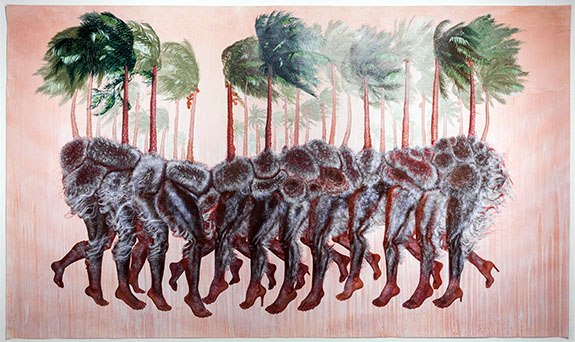
In the late 16th century, European colonists sailed westward to the Caribbean and the Americas in search of gold, but the treasure they found wasn’t indigenous; it required the forcible importation of Africans to grow and harvest sugarcane, coffee and cotton. The enduring saga surrounding these “triangular-trade” products constitutes the theme of Coffee, Rhum, Sugar & Gold: A Postcolonial Paradox at the Museum of African Diaspora (MoAD). The alluring title frames an oft-repeated theme explored over the past three decades: the stubborn legacy of colonialism.
Unlike their predecessors, the curators of this exhibition, Dexter Wimberly and Larry Ossei-Mensah, seem to be acutely aware of how globalization, international finance and climate change are in large measure the result of empire building, and how the Caribbean became its first victim. Today, however, the colonial ghost is disguised; it lurks beneath the 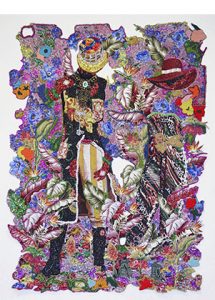
The choice to focus on artists of Afro-Caribbean descent reflects the affinity between Caribbean nations and the U.S. and African-American discourse, which remains intensely relevant to those living in both regions. The 10 artists in the exhibition all belong to the African diaspora; most are connected to or are native to the Caribbean, and most received their art training in America and continue to travel between the two regions. The exhibition concentrates on how they perceive and navigate these intricate relationships.
Despite the show’s critical stance toward stereotypical ideas of the Caribbean as a luxurious and pleasant destination, the museum walls are painted in a palm-tree green color at intervals, immersing the audience in a reductive version of a tropical archipelago. This design deliberately seeks to trap viewers in their own assumptions about paradise, which the works on view proceed to challenge. Two jacquard tapestries, titled A View In and A View Out (2015) by Jamaican artist Ebony G. Patterson, provide a remarkable example of this. Embellished with glitter, rhinestones and beads, its glistening surface and kaleidoscopic color palette dazzle to such a degree that you might easily miss the two lovers stitched into the blossomy scene. Stripped of racial traits, these two faceless, limbless figures revel in their own world, like
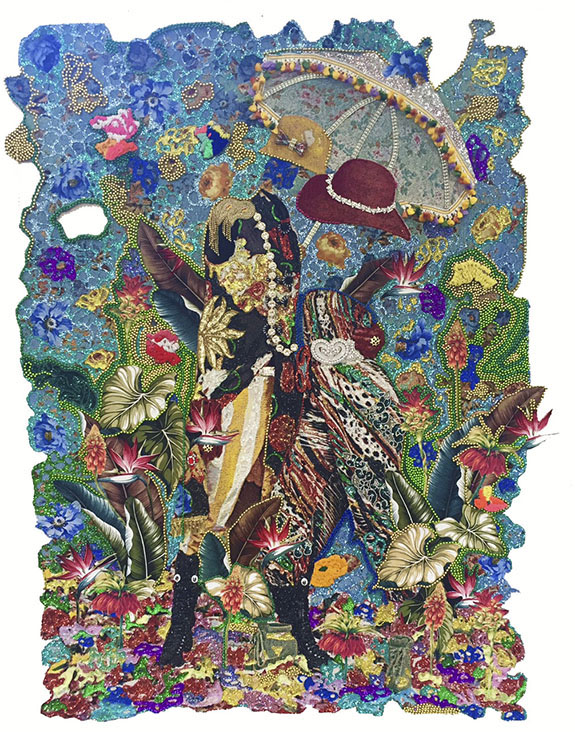
pioneers in a new land. In this we see a man in an embroidered jacket taking a woman dressed in a tube-top, leopard-patterned jumpsuit in his arms with princely delicacy. Though clothing is the only signifier of their status, it’s not hard to discern their black bodies and the decidedly African aesthetic of their clothes. An absence of flesh undercuts the seemingly romantic aura surrounding the scene. For Patterson, we can safely assume, the garden symbolizes the postcolonial experience: It is a lifestyle desired by the poor in Jamaica, a commodity taken away, brought back by the colonists and their followers, and presented as a fantasy to be reclaimed.
Another Jamaica-born artist, Phillip Thomas, presents a triptych on canvas titled Pimper’s Paradise, the Terra Nova Nights edition (2018), depicting the accumulated wealth of well-dressed black man. A casual staging of luxury items in the foreground demonstrates the artist’s concern with how wealth serves as a tool for differentiation. In the background, small black figures – plantation laborers – can be seen suffering an array of indignities: subordination, punishment, sexual bondage and surveillance. The hidden ancestry of this well-heeled black protagonist lends an eerie note to his extravagance and the unidentified source of his wealth. Unlike the white moguls in books like The Fish That Ate the Whale: The Life and Times of
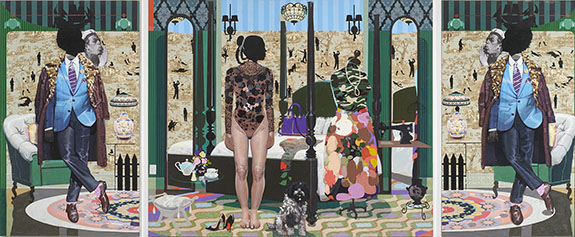
America’s Banana King and The House of Morgan: An American Banking Dynasty and the Rise of Modern Finance – two texts that inspired Wimberly’s curatorial thinking — the bigwigs in Thomas’ paintings are predominantly black, and they probe the complexity of the postcolonial status quo.
Nearby, a pack of vicious-looking dog sculptures – built of cardboard, resin, paint, marbles feathers and pieces of junkanoo costumes – break the tranquility. They are the work of Lavar Munroe, a Bahamian by birth who divides his time between Indiana and Nassau. Munroe began his Gun Dogs series while reminiscing about the eponymous street gangs in marginalized areas of Nassau where he grew up. While the Bahamas is the region’s richest state, the disparities between rich and poor nevertheless disenchanted Munroe. Although gangs often challenge the power of authorities, images of “gun dogs” and other associated perpetrators inevitably reinforce another widely held belief about the Caribbean: that it is violent and predatory. However, there’s a more profound history lurking here, too: Dogs were often

used to hunt down runaway slaves; they were not, as the saying goes, “man’s best friend.” They were, to borrow a phrase, literal “running dogs” of the white power structure, and for that reason they still arouse an instinctive fear among many people of African descent living in the Americas.
In Love that does not choose you (Collapse the rooms and structures that depend on you to hold them) (2018), Dominican-American artist Firelei Báez modifies a page of an old schematic map of the Domino Building of the American Sugar Refining Company in Brooklyn, which was once the largest such refinery in the world. Onto it she superimposes a mass of smoke and spitting orange flames. The building dates to 1882, a time when the Caribbean colonies were winning independence, and when the industrial revolution had achieved a resounding victory, ushering in yet another form of exploitation. Báez, however, doesn’t rewrite the history of the site: There actually was a fire in 1882, and in 1917 an explosion killed and injured many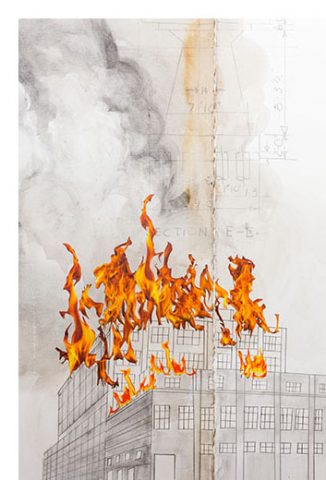
For her two-parts installation Proverbs 12:22 (2019), which sits on the floor both inside and outside of a small room with Báez’s works, Andrea Chung cooked and preserved bibles and books of hymns in sugar, and blended them with beads, rice, coins, herbs and spices. They are carefully arranged with sugar-molded gavels and strike plates, demonstrating how religion was solidified like codes of law to justify slavery. One can only faintly detect the texts underneath the translucent brown sugar. One of them is the sheet music to Amazing Grace, a hymn sung in both white and black churches. This literal melding of that specific song to the products of slavery (coffee, rhum, sugar and gold) shows the degree to which religion served the needs of commerce, and how both, operating in tandem, helped subjugate the labor force on which the colonial enterprise depended. At the same time it also points – postively – to the role played by gospel music in black culture and how it helped ease the pain of oppression.
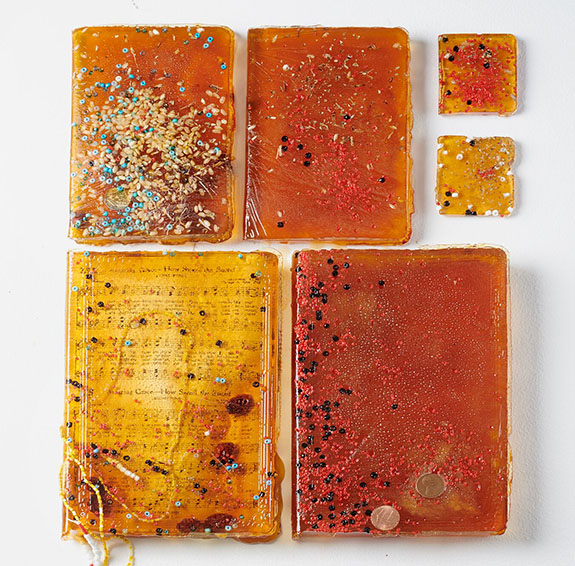
These artists don't dodge the rhetoric and materials that were used to exploit their ancestors; they use them as a lure, deftly woven into their visual language to conjure nuanced postcolonial identities and perform self-criticism. In this exhibition, the “post” in post-colonialism doesn’t imply a chronological construction of post-independence, but rather a discursive experience of in-betweeness, a continuous struggle in which art plays a vital role.
# # #
“Coffee, Rhum, Sugar & Gold: A Postcolonial Paradox @ MoAD through June 23, 2019. The exhibition also includes work by Leonardo Benzant, Angel Otero, Lucia Hierro, Adler Guerrier and Didier William.
About the author:
Ziying Duan is an independent curator and writer based in the Bay Area. She was previously assistant curator at both the Chinese Culture Foundation of San Francisco and at Kadist, San Francisco, where she handled Asia-related programming. She was a recent grantee of The Robert H.N. Ho Family Foundation Great China Research Grant (Hong Kong). Her upcoming curatorial project reconsiders the role of religion in the immigrant experience and in the Civil Rights Movement.